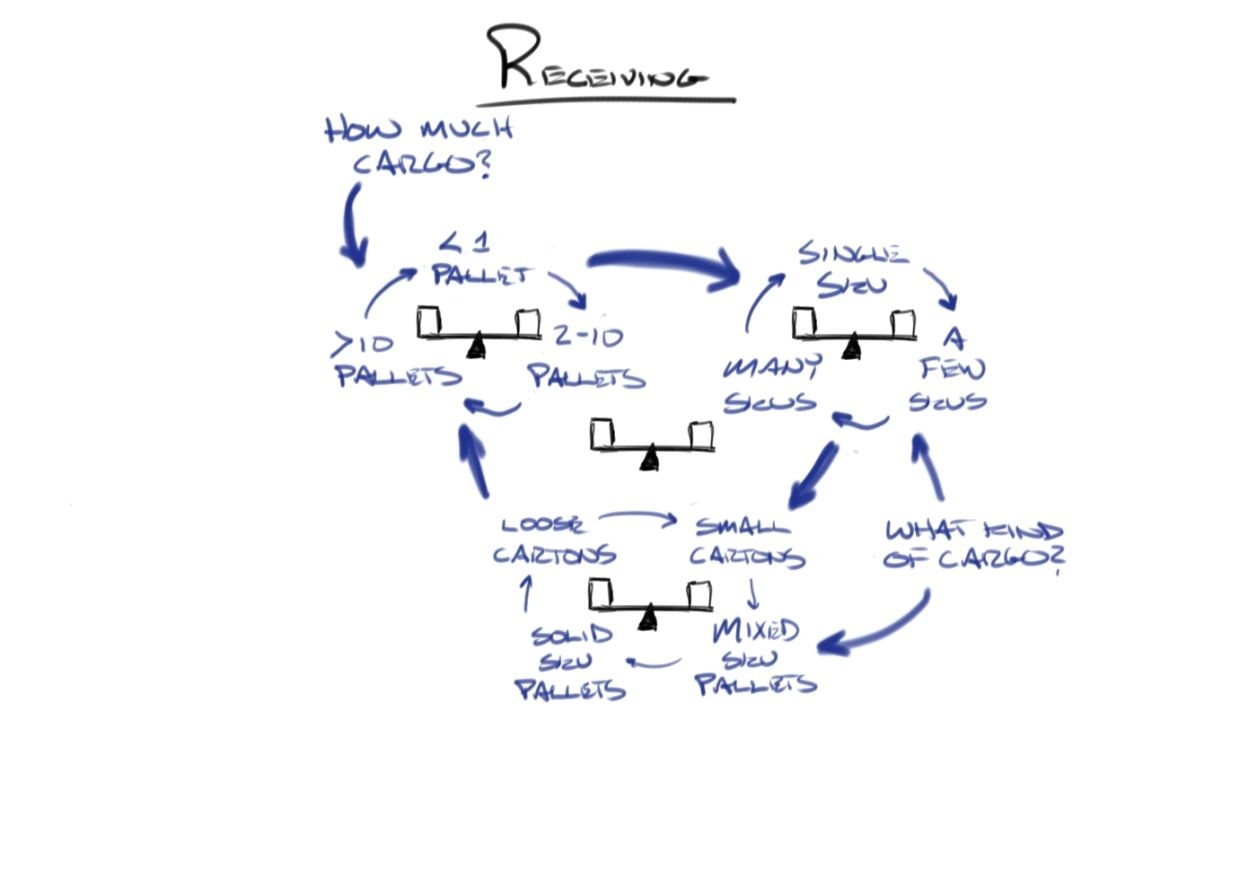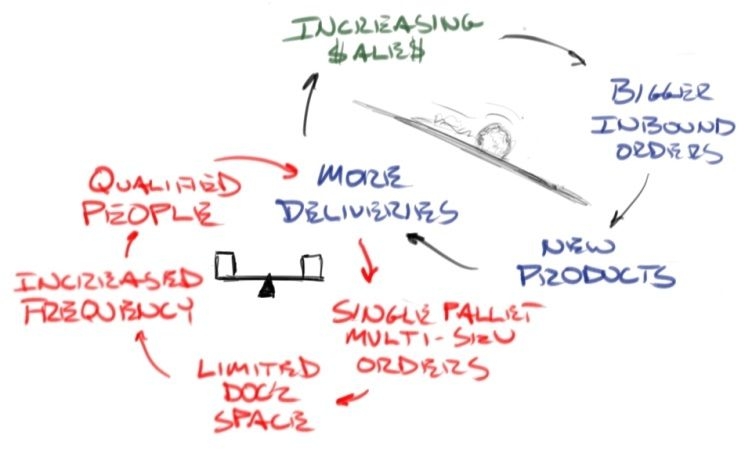
This kind of flow chart is not something that you see in business school classes. Pity.
This is a Systems Flow Chart of the Classic Receiving System. This shows when everything is working right in the system. All of the functions are in balance, each of the functions keeping up. However, let any of the functions get bottlenecked, or overflow any one of the functions and the system falls out of balance, and the whole system suffers.
In this topic we examine what happens to the receiving process of a retail hardware and building materials distribution operation. The system in the chart above may look simple, but it isn't. There are four functions, each with internal and external influences. The following story illustrates the hidden complexity behind this simple system, and how systems thinking helps optimize and improve warehouse operations.
Articles in This Series
Articles in This Series

Receiving Part 1
This is the same process that has been carried out in warehouses for over 100 years. Although the four basic steps have not changed, the ways warehouse personnel accomplish the steps has changed. Read More

Receiving Part 2
The first question, “how much cargo?” helps a manager determine how long it will take to unload the truck. The manager could use that information to decide where to unload (i.e., in what door). Read More
Receiving Part 3
The systems loops that I have been sharing in this Systems Thinking series are examples of balanced systems. The goal of these systems is balance among the various conditions and influences. Read More

Receiving Part 4
The fun part of a snowball system is watching it grow. The scary part of a snowball system is watching it grow. As the snowball rolls down the hill, its momentum builds, and it becomes harder to control what the snowball does. Read More

Receiving Part 5
I thought about what Tom said. It made sense. Most of the new product would ship out to the stores so they could fill their shelves, and only a fraction would remain behind to be the backup stock. After the stores started to sell the new product, we would ship replenishment orders. Read More
Receiving Part 6
The many SKU small shipments became a nuisance. Before the tool department changeover only one or two 100 SKU orders crossed the docks in a month. After the tool department makeover, it felt like we had nothing but these high SKU-count orders.
Our receiving process was simple and methodical. We unloaded the freight, did a carton count, and inspected for damage.
Receiving Part 9
As I drove back to the DC from the store, I thought about the differences between the ways Jackie ran the Paint department and Steve ran the Tool department. At first blush I thought that Steve was a better manager — Tools looked so much tighter than Paints. The more I thought about it, however, the more I realized that the differences between the departments were not...
Receiving Part 12
The receiving and warehousing operations that I managed were not insignificant. I may have felt insignificant on Friday as I drank another round of beer with the buyers, but that was just the beer. On Saturday morning, over my second cup of coffee, I realized that no part of the process was insignificant. The parts were all interrelated, interconnected, and interdependent. Remove one part and the retail process would break down.
Receiving Part 7
Before I left the store, I talked to the department managers in Tools and Paints. If I wanted to get the whole story, I needed to talk to these people.
In the stores, the receiving staff unloaded the product and received the goods into the book inventory. The physical movement of the product out of receiving and onto the floor was the responsibility of the merchandise department teams.
Receiving Part 10
As I worked through the rest of the day, I kept thinking about the differences I had seen that morning between the Paint and Tool departments. It was clear to me that how the merchandise category managers planned their assortments was only part of the puzzle. I could see a clear difference between the way one merchant set up the Paint Program and the way another merchant set up the Tool Program. They did not do it the same way, and that confused me.
Receiving Part 8
The tool department was astounding. I remembered having visited this store about six months earlier, before the new tool program rolled out. It was remarkable. The display of hand tools, power tools, and accessories was a little overwhelming — there was so much. What I did not see was empty peghooks. Every spot had something hanging, and every shelf was filled.
Receiving Part 11
“Here is the replenishment pitcher,” I said, as I refilled the empty glasses with beer from the cold, frosty pitcher.
After a deep drink from his mug, Paul started in. “Patty, How many new SKUs are in the Tool program now?”
“We picked up about 400 SKUs in the distribution center, and the direct program added about 700 SKUs.”


